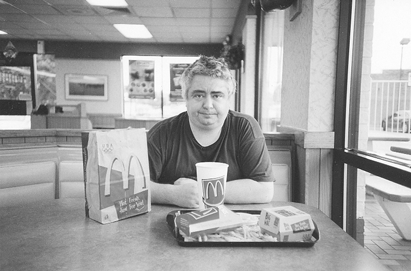By Rania Richardson
“I’ve cheered up a lot and I’m writing again. I’m having a lot of fun,” said Daniel Johnston from his home in Waller, Texas in a recent phone interview. The underground artist, whose homemade music and cartoon drawings have earned him a cult following, is the subject of a new documentary by Jeff Feuerzeig which opens Friday.
“The Devil and Daniel Johnston” traces the dramatic life of the 45-year-old artist, whose devout Christian background and bipolar illness inform his prolific work. It’s a relief and a surprise that he is now in good spirits, given the hard times revealed in the film. Johnston spoke by speakerphone, surrounded by friends and family during the call placed from the Jersey City art studio of Ron English, a friend and frequent collaborator. Throughout the conversation, he was enthusiastic and affable, and as candid as the lyrics he writes.
“It was 5 years of my life, in and out of mental hospitals. It was a drag being locked up,” he said of the dark period following a botched record deal that propelled him to stardom. His ensuing breakdown is chronicled in the film. “That’s when he started smoking cigarettes,” said his sister Cynthia, in a concerned tone.
Cigarettes, fast food, and recreational drugs seem to fuel Johnston’s obsessive existence, and a lifelong fixation with the Beatles drives his music. He is a Beatles collector and owns all their albums, “many times over.” He even sports a (now graying) mop of hair.
“I learned from the Beatles to have songs simple to understand and simple in structure. They’re short and sweet, usually,” he said. “There’s a little bit of humor and fans catch onto that and they want to hear more wondering ‘What’s the joke this time?’”
Johnston’s songs in the film include “Casper the Friendly Ghost,” “Frito Lay,” “Don’t Play Cards with Satan,” “Museum of Love, and “See My Soul Stretched Out to the Sky.” He said he does not keep up with the latest bands, and only now and again makes the 2 1/2 hour drive to Austin to hear music. He is currently listening to “Rock ‘n’ Roll,” John Lennon’s cover album of 1950s hits, and regularly listens to Yoko Ono’s avant-garde albums. There is no Internet access in his home, but he does enjoy movies from the local video store. We just rented ‘About Schmidt’ the other day,” his female friend said. “Jack Nicholson is cool,” added Johnston.
At the 2005 Sundance Film Festival, “The Devil and Daniel Johnston” was nominated for a grand jury prize and Feuerzeig won the director’s award. “It was pretty depressing,” Johnston said of seeing his life portrayed on the big screen, and laughed at the suggestion that his life is particularly fascinating. “Everybody’s life is fascinating,” he countered. The filmmakers and festival audiences seemed to like the film a lot, though. “That’s what’s important,” he said, revealing his eager-to-please personality.
Johnston has been known to hand out his music cassettes and drawings for free, to the consternation of his family, who would prefer he didn’t give away his profits. His protective father manages his affairs and is wary of reporters and being misquoted. He said he is disappointed that he has not received a hard copy of the recent New York Times profile of his son about his inclusion in the current Whitney Biennial.
Ron English is a friend of the Johnston family and is known for his satiric artwork and for posting anti-establishment billboards on the sly. He is the subject of his own documentary by Pedro Carvajal, a recently released DVD called “POPaganda: The Art and Crimes of Ron English.” Johnston appears in that film as a partner in art and music projects. The two artists have a similar comic sensibility, but English is the more political. His billboards subvert the messages of corporate advertising with lines such as KEEP HOPE A LIE and JIHAD IS OVER (IF YOU WANT IT).
English’s illustrations of cigarette puffing clowns and obese Ronald McDonalds were used in the film “Super Size Me,” a critique of the fast food industry. Johnston saw the movie, but was unaffected by it. “Oh, yeah, I still go to McDonald’s,” he said. “It’s one of my favorite places to eat.” His infatuation with the fast food chain even inspired him to write the song “McDonald’s on the Brain,” after working there in the 1980s. “I was working at McDonald’s when I got on MTV. People would come in and say ‘Hey, I saw you on MTV!’” he said, referring to the television appearance that made him a minor celebrity. The experience and the food is still a highlight in his life. “It is good food if it’s cooked right,” he said.
WWW Downtown Express


































